
The Bottom Line
Pros
- 4K 120FPS performance
- COLORFUL's design is unique, with decent thermal performance
- Faster than the Founders Edition model
- DLSS 4 is a game-changer for image fidelity and performance
- Multi Frame Generation is great for high refresh-rate displays
Cons
- Modest raw performance uplift over the GeForce RTX 4080
- An $899 MSRP would make it the high-end GPU to get in 2025
Should you buy it?
AvoidConsiderShortlistBuyIntroduction
COLORFUL offers a range of different-looking GeForce RTX cards. With the arrival of the new Blackwell-powered GeForce RTX 50 Series, we enjoyed checking out the new COLORFUL iGAME GeForce RTX 5080 Ultra W OC model for review. Now, one of the first things you'll notice about this particular RTX 5080 card is that it looks unlike any other GeForce RTX 5080. According to COLORFUL, the physical look was inspired by hip-hop and street art culture. It doesn't stop there, as it's also a design tailor-made for white PC builds, where on top of the white and pink colors, you've got some holographic flourishes and some bright neon purple lighting when you plug it in and turn it on.
A quick look at the COLORFUL iGAME GeForce RTX 5080 Ultra W
When picking up a new GPU, a lot of people aren't too phased about the look. You might fall into this camp or look for a clean, minimal, all-black affair, something with a little bit of RGB, something with a lot of RGB, or something as vibrant as what COLORFUL's cooked up here. As someone who does like the all-white PC aesthetic that has become popular in recent years, with its neon colors and graffiti art, the COLORFUL iGAME GeForce RTX 5080 Ultra W OC is something I'd consider picking up and slotting into a white rig. Or building an entire system around it.
Of course, when it comes to reviewing a new GPU, gaming performance and cooling efficiency are more important than a funky physical design. However, seeing something a little different in a sea of black-and-grey industrial sci-fi-looking GPUs is always great.

As the name suggests, the iGAME GeForce RTX 5080 Ultra W is an OC model. As we've benchmarked a few different RTX 5080s, we can safely say that it's a GPU with enough headroom to get an additional 5% or even 10% extra performance over the reference or Founder Edition spec, depending on the game or workload. For this review, we ran our benchmarks using the GPU's "Turbo" OC mode, which you can activate via a button on the exhaust.
What does this mean for its overall gaming performance? Well, when it comes to 4K gaming across a wide range of titles with and without ray tracing, the COLORFUL iGAME GeForce RTX 5080 Ultra W OC is 22% faster than the GeForce RTX 4080 and an impressive 88% faster than the GeForce RTX 3080. Throw in DLSS 4, and you have one of the best high-end 4K PC gaming options.

| Today | 7 days ago | 30 days ago | ||
|---|---|---|---|---|
| $926.91 USD | $926.91 USD | |||
| $926.91 USD | $926.91 USD | |||
| - | £906.28 | |||
| $926.91 USD | $926.91 USD | |||
|
* Prices last scanned on 2/7/2025 at 11:27 am CST - prices may not be accurate, click links above for the latest price. We may earn an affiliate commission from any sales.
|
||||
RTX Blackwell - NVIDIA's Gaming Architecture for the AI Era
Below is a summary of NVIDIA's GeForce RTX 50 Series and RTX Blackwell architecture, applicable to all models.
NVIDIA describes 'Neural Rendering,' which includes all previous versions of DLSS and the brand-new DLSS 4, as the 'next era for computer graphics.' They're not alone; the Lead System Architect for the PlayStation 5 Pro console, Mark Cerny, recently said that ray-tracing is the future of games and that AI will play an integral role in making that happen. DOOM: The Dark Ages developer id Software shared a similar sentiment, adding that the arrival of DLSS was an 'inflection point' for PC game visuals and performance and on par with the arrival of dedicated GPUs and programmable shaders.
With the arrival of the Blackwell generation and the GeForce RTX 50 Series, AI is now being used to accelerate programmable shaders with the brand-new RTX Neural Shaders. Yes, these are actual neural networks that use live game data, and the power of Tensor Cores to do everything from compress textures, render lifelike materials with a level of detail impossible to match using traditional rendering methods, and even use AI to partially trace rays and then infer "an infinite amount
of rays and bounces for a more accurate representation of indirect lighting in the game scene."
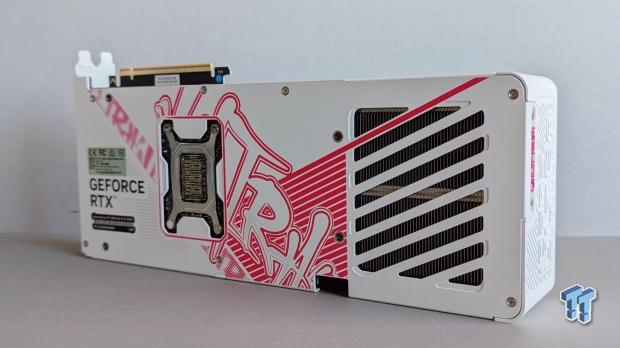
RTX Mega Geometry is incredible in its own right; it essentially increases a scene's geometry detail and complexity (triangles or polygons) by up to 100x. 100 times the detail, it's hard to wrap your head around - but the added benefit in a game like Alan Wake 2 is dramatically improving the performance of the game's Full Ray Tracing or Path Tracing mode. With DLSS 4 and RTX Neural Shaders, NVIDIA's GeForce RTX 50 Series and RTX Blackwell architecture (which includes the same AI optimizations as data center Blackwell) can be viewed as the turning point for PC gaming - the moment when AI becomes integral to everything from designing a game to programming and then finally rendering it on a 4K display to play.
DLSS 4 includes more goodies than NVIDIA's highly touted new Multi Frame Generation technology, but let's start there. DLSS 3's version of Frame Generation has evolved with DLSS 4, powered by Blackwell hardware and software, and an innovative use of AI to generate frames 40% faster while using 30% less VRAM. Switching to a new model also means that Frame Generation and Multi-Frame Generation could soon come to GeForce RTX 20, 30, and RTX 40 Series owners. DLSS 4 benefits all GeForce RTX gamers.
However, with the 5th Generation of Tensor Cores in the GeForce RTX 50 Series delivering 2.5X more AI performance, NVIDIA's latest GeForce RTX 50 Series GPUs can execute five complex AI models - covering Super Resolution, Ray Reconstruction, and Multi Frame Generation in a couple of milliseconds. Part of the reason it happens so quickly is the addition of hardware Flip Metering, which shifts frame pacing to the Blackwell display engine - the result is frame rates of up to 4K 240 FPS and higher without stuttering issues. With up to 15 of every 16 pixels generated by AI, the result is up to 8X the performance when compared to native rendering or rasterized performance.
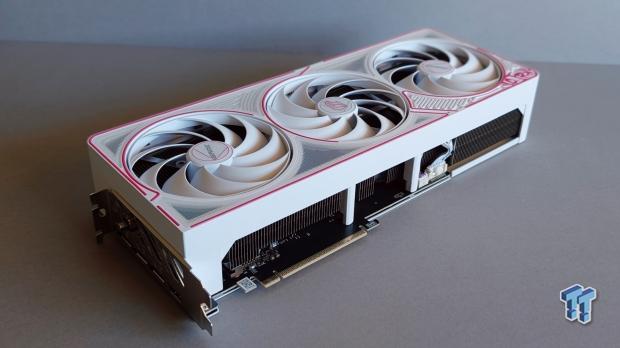
DLSS Super Resolution and Ray Reconstruction are also switching to a new 'Transformer' model, with over double the parameters and four times the compute requirement. This is one of the most exciting aspects of the GeForce RTX 50 Series, as it pushes DLSS into a new realm of image quality and performance. The best part is that it will work on all GeForce RTX GPUs; however, there will be a performance hit compared to running it on an RTX 50 Series GPU. Already available in games, DLSS 4's Transformer model is another DLSS 2.0-like moment for the technology, and the results speak for themselves.
Even better, DLSS 4 is being integrated into the NVIDIA App with a new 'DLSS Override' feature that allows users to experience the latest tech without waiting for a path or game update. DLSS 4 is built to be backward compatible, with 75 games and apps supported.
It doesn't stop there, as the new AI Management Processor (AMP) allows AI models to share the GPU with graphics workloads. As a result, expect to see digital humans in games alongside AI assistants like NVIDIA's Project G-Assist become more prevalent in the coming years. This filters down to the creator side, with AI assistants for streamers, who will also benefit from the GeForce RTX 50 Series' expanded creator features.
RTX Blackwell introduces 4:2:2 chroma-sampled video encoding and decoding. The ninth-generation NVENC encoder also improves AV1 and HEVC quality. The flagship GeForce RTX 5090 supports up to three encoders and two decoders to deliver a 50% gen-over-gen improvement in speed compared to the GeForce RTX 4090. The GeForce RTX 5080 adds a second decoder compared to the GeForce RTX 4080. The RTX Blackwell is a game changer for creators and editors, especially with the new low-voltage and cutting-edge GDDR7 memory that dramatically improves memory bandwidth and speed.
Specs and Test System
Specifications
Here's a look at the specs for the flagship GeForce RTX 50 Series GPUs, the GeForce RTX 5080 and GeForce RTX 5090, compared to the previous Ada generation.
| GPU Specs | GeForce RTX 5090 | GeForce RTX 4090 | GeForce RTX 5080 | GeForce RTX 4080 |
|---|---|---|---|---|
| Architecture | Blackwell | Ada Lovelace | Blackwell | Ada Lovelace |
| Process | TSMC 4N | TSMC 4N | TSMC 4N | TSMC 4N |
| CUDA Cores | 21760 | 16384 | 10752 | 9728 |
| Tensor Cores (AI) | 680 (5th Gen) | 512 (4th Gen) | 336 (5th Gen) | 304 (4th Gen) |
| AI TOPS | 3352 | 1321 | 1801 | 780 |
| Ray Tracing Cores | 170 (4th Gen) | 128 (3rd Gen) | 84 (4th Gen) | 76 (3rd Gen) |
| GPU Boost Clock | 2407 MHz | 2520 MHz | 2617 MHz | 2505 MHz |
| Memory | 32GB GDDR7 | 24GB GDDR6X | 16GB GDDR7 | 16GB GDDR6X |
| Memory Interface | 512 Bit | 384 Bit | 256 Bit | 256 Bit |
| Bandwidth | 1792 GB/sec | 1008 GB/sec | 960 GB/sec | 716.8 GB/sec |
| TGP | 575W | 450W | 360W | 320W |
With the GeForce RTX 50 Series generation, outside of the flagship GeForce RTX 5090, with the same or similar process node, the actual specs only see a modest upgrade over the GeForce RTX 40 Series. With the GeForce RTX 5080, you're looking at 11% more CUDA, Tensor, and RT Cores than the GeForce RTX 4080. Although Blackwell features architectural upgrades for new AI rendering and other improvements, the typical generation uplift of 30+ percent for overall or raw performance is missing.
Ultimately, this means that for the first time, an 80-class GeForce RTX graphics card isn't outperforming the previous generation's flagship - in this case, the GeForce RTX 4090. The GeForce RTX 5080 is more than 11% faster than the GeForce RTX 4080, which means that performance and efficiency improvements can be gained outside of moving to a smaller process node. However, it does feel like we're getting closer to the point where we'll no longer see the significant gains you get moving from 12nm to 8nm or 8nm to 4nm.
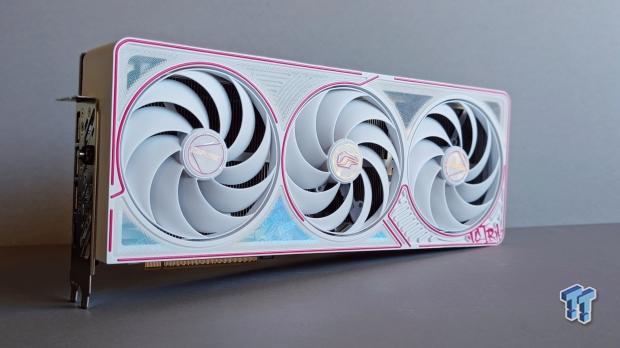
The good news is that NVIDIA hasn't just discovered AI; with the Blackwell architecture and new AI-enhanced tools and technologies, it feels like they've hit a new level of performance and quality. DLSS 4's new Multi Frame Generation feature might be exclusive to the GeForce RTX 50 Series. Still, the significant updates to the existing Frame Generation model, DLSS Super Resolution, and Ray Reconstruction's new Transformer model are transformative to image fidelity and overall performance. These features are available to all GeForce RTX gamers, with GPUs like the GeForce RTX 5080 introducing more advanced Tensor Core hardware to ensure these more complex DLSS models run faster.
In addition, Blackwell is primed and ready for RTX Neural Rendering, a suite of new and impressive AI technologies designed to boost ray-tracing performance and image quality. Only a single piece of it is available to test - RTX Mega Geometry has been added to Alan Wake 2. This will be one part of the new GeForce RTX 50 Series that will take some time to filter down into the games we play.
As an OC model, the COLORFUL iGAME GeForce RTX 5080 Ultra W OC offers a Turbo mode that takes the reference boost clock speed of 2617 MHz and pushes it to 2655 MHz. A modest upgrade, however, with COLORFUL's iGAME Center software or a third-party app (or even the NVIDIA App), can be pushed even higher.
| Item | Details |
|---|---|
| GPU | GeForce RTX 5080 |
| GPU Codename | GB203 |
| Model | COLORFUL iGAME GeForce RTX 5080 Ultra W OC |
| Interface | PCI Express Gen 5 |
| SMs | 84 |
| CUDA Cores | 10752 |
| Tensor Cores (AI) | 1801 AI TOPS (5th Gen) |
| Ray Tracing Cores | 171 TFLOPS (4th Gen) |
| Boost Speed | 2617MHz or 2655 MHz (Turbo Button) |
| Memory | 16GB GDDR7 |
| Memory Interface | 256-bit |
| Memory Speed | 30 Gbps |
| Memory Bandwidth | 960 GB/sec |
| L2 Cache Size | 65536 KB |
| TGP | 360W |
| Display | 3 x DisplayPort 2.1b with UHBR20, 1 x HDMI 2.1b |
| Display Output | Up to 4K 12-bit HDR at 480Hz, Up to 8K 12-bit HDR at 165Hz |
| Power Input | 16-pin PCIe (3 x 8-pin to 1 x 16-pin adaptor included) |
| Dimensions | 331 x 139 x 60 mm |
| Weight | 1840 grams |
Kosta's Test System
| Item | Details |
|---|---|
| Motherboard | ASUS ROG CROSSHAIR X670E HERO |
| CPU | AMD Ryzen 9 7950X |
| GPU | NVIDIA GeForce RTX 4090 Founders Edition |
| Display | MSI MAG 321UPX QD-OLED 4K 240 Hz |
| Cooler | ASUS ROG RYUO III 360 ARGB |
| RAM | 32GB DDR5-6000 Corsair DOMINATOR TITANIUM RGB |
| SSD | Sabrent Rocket 4 Plus-G M.2 PCIe Gen 4 SSD 4TB, Sabrent Rocket 4 Plus Plus M.2 PCIe Gen 4 SSD 8TB |
| Power Supply | ASUS TUF Gaming 1000W Gold |
| Case | Corsair 5000D AIRFLOW Tempered Glass Mid-Tower ATX PC Case |
| OS | Microsoft Windows 11 Pro 64-bit |
Physical Design and Cooling
Inside the funky while and hip-hop-inspired exterior, the COLORFUL iGAME GeForce RTX 5080 Ultra W OC houses an effective cooling system that has no issue keeping temperatures in check. Although it doesn't quite sit on the large side for a GeForce RTX 5080, the three-slot thickness and 1840-gram weight are nothing to sneeze at. With three fans, where the middle fan spins on a different axis from the outer fans, and a decent-sized heatsink, there's ample cooling headroom for overclocking.
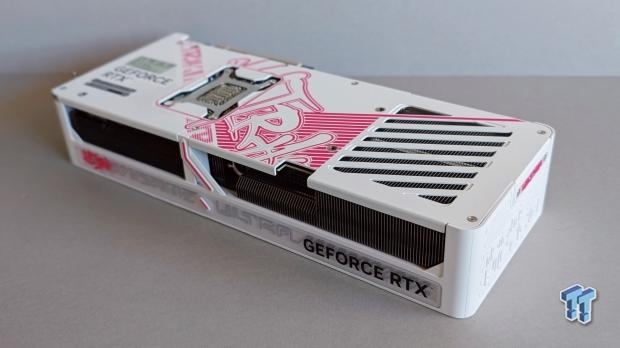
A lot of the features are what you'd expect to find on a high-end GPU like this: dual ball bearings for long-lasting and quiet fans, an auto-stop feature that has the fans stop once the temperatures drop below a certain threshold, high-quality heat pips, and fins for heat dissipation, a metal backplate with vents for airflow, and software support for monitoring and tweaking settings - wither everything from lighting to fans speeds and curves accounted for.
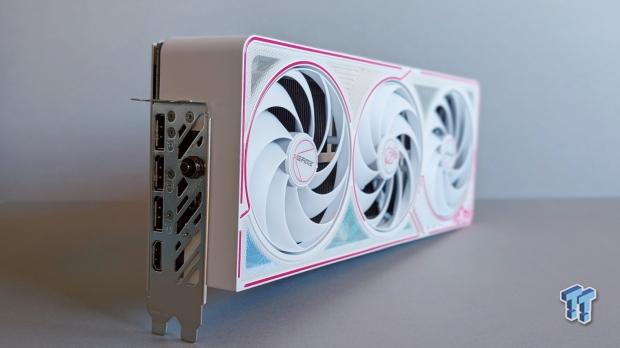
As the introduction mentions, the COLORFUL iGAME GeForce RTX 5080 Ultra W OC stands out in a sea of custom GeForce RTX 5080 designs. The blend of graffiti art, hot neon pink, holographic flourishes, and an RGB strip running down the side make it a looker once installed. Unfortunately, the only thing missing is a custom white PCB. However, COLORFUL packs a white 8-pin to 16-pin power adapter, which is a nice touch. It's a stylish design, perfect for all-white builds or those looking for something much more vibrant, and a thermal solution that works well to cool the GPU even after you press the 'Turbo' button next to the video outputs.
The Games and Tests
PC gaming not only covers a wide range of genres and styles, from indie games with simple 2D graphics to massive 3D worlds lit by cutting-edge real-time ray tracing technology. With that, the needs and requirements of each gamer vary. High refresh rates and latency reduction become more important than flashy visuals or playing at the highest resolution possible for those who live and breathe fast-paced competitive games. For those who want to live in a cinematic world and become a key player in an expansive narrative, ray-tracing, and high-fidelity visuals are a stepping stone toward immersion.
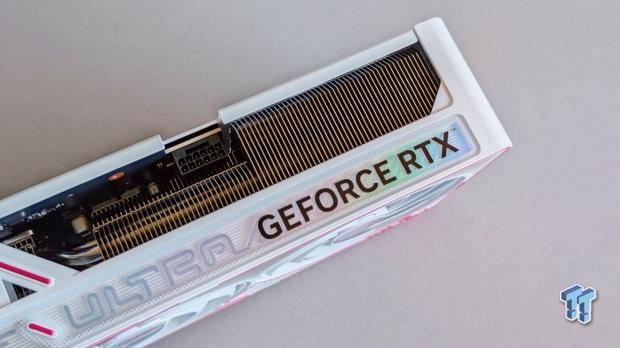
Our chosen benchmarks cover various games, engines, APIs, and technologies. For the GeForce RTX 5090, all tests are run at 4K and 1440p and include results for performance-boosting Super Resolution technologies like NVIDIA DLSS 4 - including Frame Generation and the new Multi Frame Generation. In many ways, DLSS numbers are more important in 2025 than native rendering - a title with ray tracing isn't meant to be played without Super Resolution. Also, DLSS technologies like Ray Reconstruction and the new RTX Mega Geometry dramatically improve visual fidelity and detail compared to native rendering. However, our benchmark results are still sorted using 'raw performance' or native rendering.
Here's the breakdown of games, settings, and what's being tested.
Games and Settings Benchmarked
| Game | Details |
|---|---|
| Black Myth: Wukong | A high-impact Unreal Engine 5 test showcasing a detailed cinematic world. The in-game benchmark tool with the 'Very High' fidelity setting without ray-tracing and with DLSS and FSR. |
| Cyberpunk 2077 | Competitive multiplayer FPS test with DLSS and FSR. The in-game multiplayer benchmark tool is used with 'Ultra' quality settings. |
| Counter-Strike 2 | Competitive multiplayer FPS test running on Valve's Source 2 engine. A stress test mod map is used to showcase CS2 at its most demanding. |
| Cyberpunk 2077 | Cinematic open-world test with stunning visuals and DLSS and FSR. The in-game benchmark tool is used with 'Ultra' quality settings without ray-tracing. |
| Cyberpunk 2077 (RT) | Cinematic open-world test with stunning visuals and DLSS and FSR. The in-game benchmark tool is used with the demanding 'Ray Tracing Ultra' quality setting. |
| DOOM Eternal (RT) | Fast-paced single-player FPS gaming running on the id Tech and Vulkan with DLSS. The Mars Core campaign mission is used to benchmark. |
| Dragon Age: The Veilguard (RT) | Cinematic RPG from veteran studio BioWare, benchmarking the action-packed introduction sequence with Ultra quality settings including ray-tracing with DLSS and FSR. |
| F1 24 (RT) | Racing game with hardware-intensive in-race ray-traced visuals and DLSS and FSR. The in-game benchmark tool is used, with 'Ultra High' quality settings on a single lap of the Bahrain track. |
| Hogwarts Legacy (RT) | Cinematic open-world game set in the iconic Harry Potter universe. The halls and rooms of Hogwarts used to benchmark, with 'Ultra' quality settings, ray-tracing, DLSS and FSR. |
| Horizon Forbidden West | Cinematic open-world test with stunning visuals and DLSS and FSR. The opening section is tested using the 'Very High' quality setting. |
| Marvel Rivals | Multiplayer hero shooter set in the Marvel universe, in-game Practise Range map used to benchmark with 'Ultra' quality settings, DLSS and FSR. |
| Resident Evil 4 (RT) | Capcom's visually impressive remake, Chapter 1 - The Village used to benchmark with 'Max' settings. |
| Total War: Warhammer III | Action-packed real-time strategy with hundreds of on-screen characters. The in-game 'Battle' benchmark tool is used with the 'Ultra' quality setting. |
| Warhammer 40K: Space Marine 2 | Cinematic third-person action game with impressive visuals. Opening mission tested using 'Ultra' quality setting with DLSS and FSR. |
Path Tracing Games and Settings Benchmarked
| Game | Details |
|---|---|
| Alan Wake 2 | Full Path Tracing tested in 4K using the new 'Ultra' setting with DLSS 4, Frame Generation, and Multi Frame Generation. Bright Falls town used to test. |
| Black Myth: Wukong | A high-impact Unreal Engine 5 test with DLSS 'Performance' and Frame Generation. The in-game benchmark tool with the 'Very High' setting and 'Full Ray Tracing.' |
| Cyberpunk 2077 | In-game benchmark tool used with the demanding 'RT Overdrive' or full Path Tracing mode, with DLSS 4 Performance, Frame Generation, and Multi Frame Generation. |
| Indiana Jones and the Great Circle | Full Ray Tracing tested in this stunning first-person cinematic game, Marshall College walkthrough used to test with DLSS Performance and Frame Generation. |
| Star Wars Outlaws | Open-world Star Wars game with cutting-edge ray-traced visuals and DLSS 4 technologies tested, including Multi Frame Generation on Toshara. |
Gaming Performance Analysis
Average Gaming Performance - 4K Results
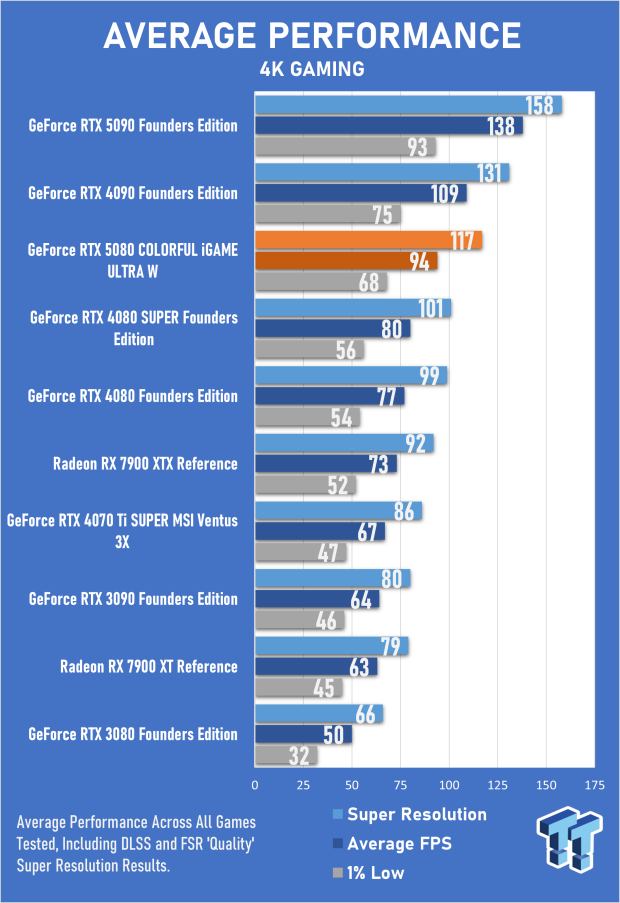
The COLORFUL iGAME GeForce RTX 5080 Ultra W OC is the sort of GPU that you need to pair with a 4K or Ultrawide display to get the most out of it. Only at these ultra-high resolutions can you get a clearer picture of the performance uplift it provides over previous generation 80-class GPUs like the GeForce RTX 4080 and the GeForce RTX 3080. Compared to the GeForce RTX 4080, you're looking at 22% faster 4K gaming on average, with that number dropping to 17% when looking at the GeForce RTX 4080 SUPER - a refresh that is only a year old.
Looking back further to the GeForce RTX 3080, the new GeForce RTX 5080 is a whopping 88% faster - a massive improvement. As the third most powerful GPU for 4K gaming, the GeForce RTX 4090 is 16% faster than the COLORFUL iGAME GeForce RTX 5080 Ultra W OC, while the new flagship GeForce RTX 5090 is 47% faster. Looking at the flagship Radeon RX 7900 XTX, which could be AMD's most powerful option for another generation depending on how the Radeon RX 9070 XT pans out, the iGAME GeForce RTX 5080 Ultra W is a sizable 29% faster.
For a more nuanced look at game-to-game performance, go through the individual benchmarks below, as the results can vary wildly from title to title. Call of Duty: Black Ops 6 runs 17% faster on the GeForce RTX 5080 compared to the GeForce RTX 4080; however, it's still 5% slower than the Radeon RX 7900 XTX - the only 4K win for AMD's flagship in our testing. Looking at two Unreal Engine 5 games, Black Myth: Wukong and competitive shooter Marvel Rival, both run 18% faster on the RTX 5080 than the RTX 4080. On the other end of the spectrum, Counter-Strike 2 runs 29% faster on the RTX 5080.
Average Gaming Performance - 1440p Results
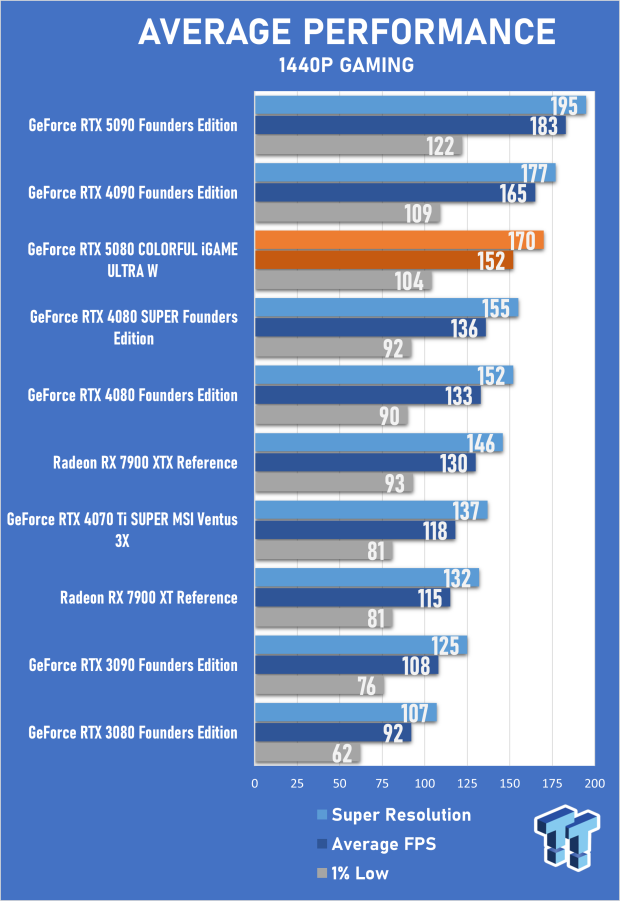
Drop the resolution to 1440p, and the COLORFUL iGAME GeForce RTX 5080 Ultra W's lead over the GeForce RTX 4080 shrinks to 14%, with its lead over other GPUs also dropping - Radeon RX 7900 XTX (16%) and GeForce RTX 3080 (65%). At this resolution, we see the GPU run into more CPU and game engine bottlenecks as the GeForce RTX 5080's performance also sees its performance get within 10% of the GeForce RTX 4090. That said, when it comes to games with lots of ray-tracing like Cyberpunk 2077, Dragon Age: The Veilguard, and Hogwarts Legacy - dropping the resolution down to 1440p with DLSS enabled does deliver smooth triple-digit FPS gaming.
Benchmarks - 3DMark Synthetic Tests
3DMark offers a suite of synthetic benchmarks built to test GPUs in various scenarios. 3DMark Steel Nomad is a cutting-edge DirectX 12 benchmark with newer, modern rendering techniques designed to push GPUs to their limit. The 'Light' version tests at 1440p, while the main Steel Nomad benchmark tests pure native 4K rendering. Port Royal is a benchmark focusing exclusively on real-time ray tracing for lighting effects like reflections, shadows, and more.
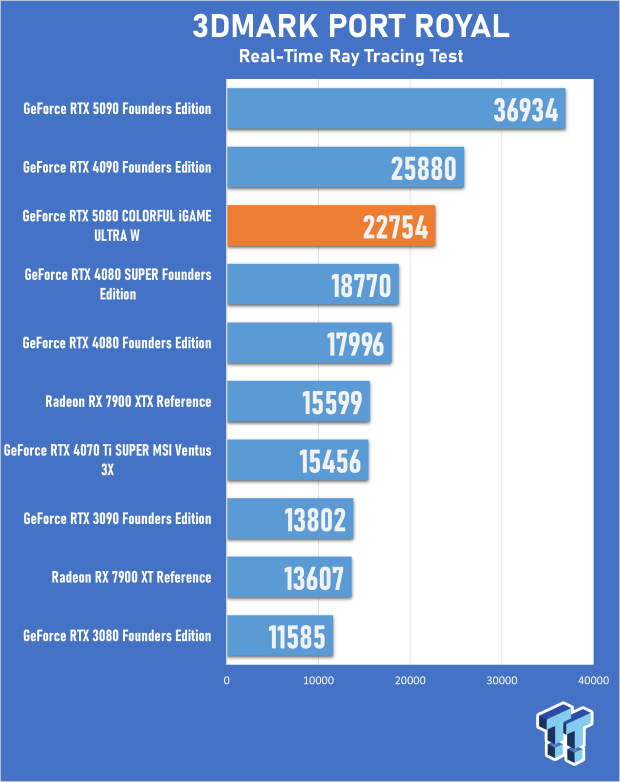
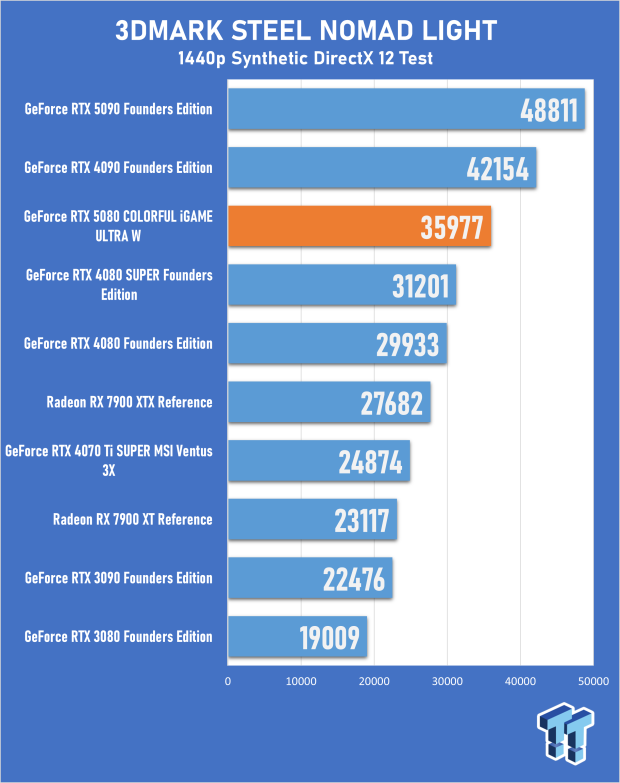
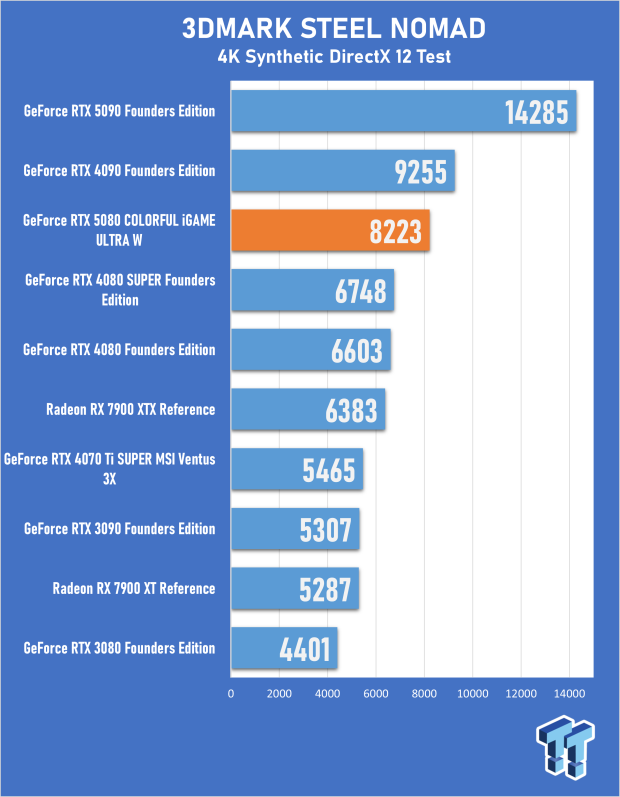
3DMark Steel Nomad is the successor to Time Spy and has been designed to test more modern non-RT rendering techniques, such as those used in Unreal Engine 5. In the 1440p-based 3DMark Steel Nomad Light synthetic benchmark, the COLORFUL iGAME GeForce RTX 5080 Ultra W's score is 20% higher than the GeForce RTX 4080's score - which is indicative of the in-game results we're seeing. Bump things up to the 4K-based 3DMark Steel Nomad, and that lead grows to 24%, a result we only see in a handful of games.
Switching to the ray-tracing 3DMark Port Royal synthetic benchmark, the lead grows again to 26%; however, when it comes to the ray-tracing workloads in the games included in our benchmark suite, the figure we're seeing is closer to 20%. When it comes to super-intensive Path Tracing, cards like the GeForce RTX 4090 and the new GeForce RTX 5090 benefit from their increased VRAM and more RT Cores.
Benchmarks - 4K Gaming
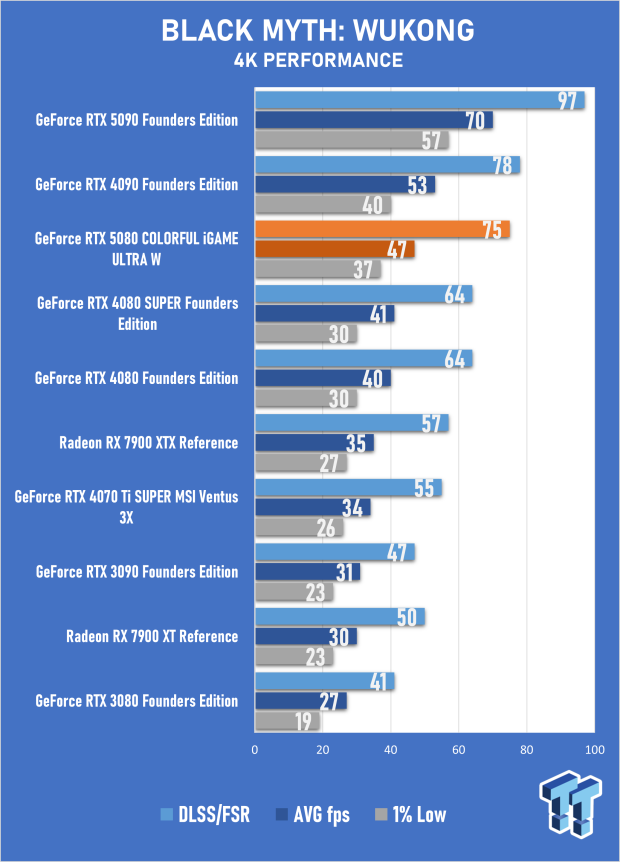
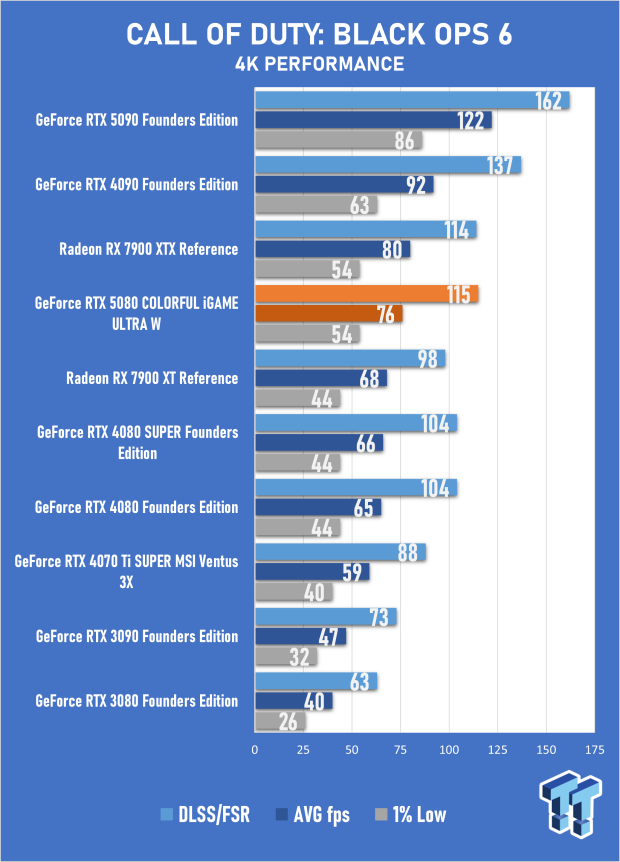
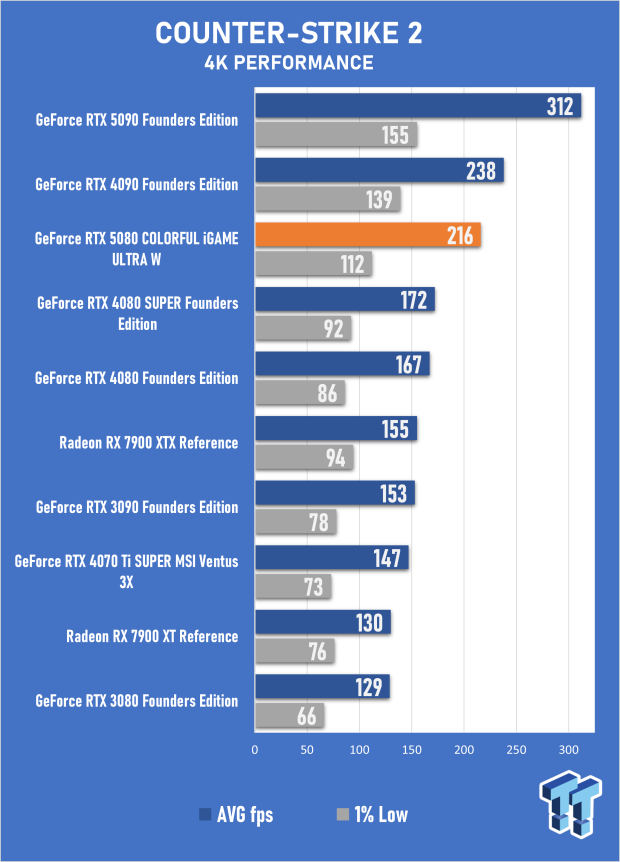
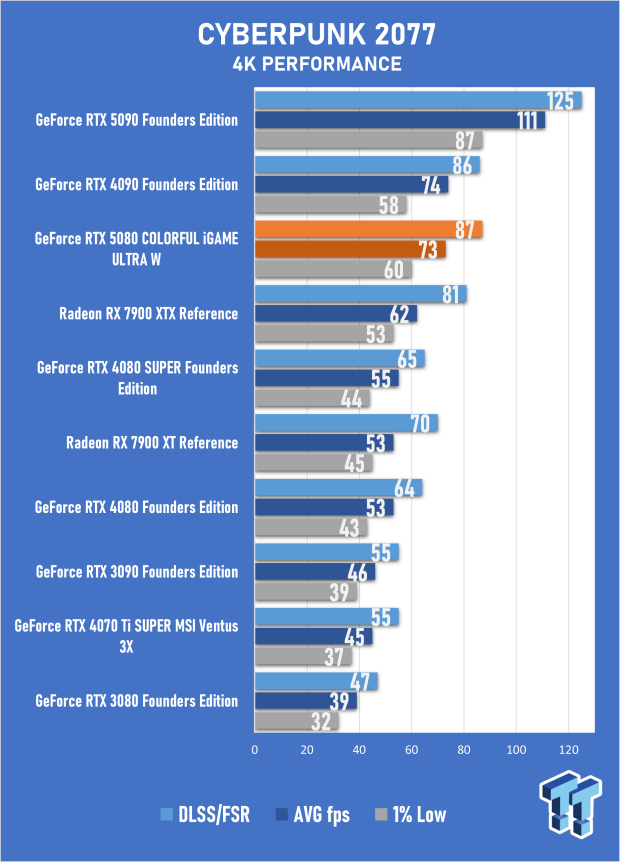
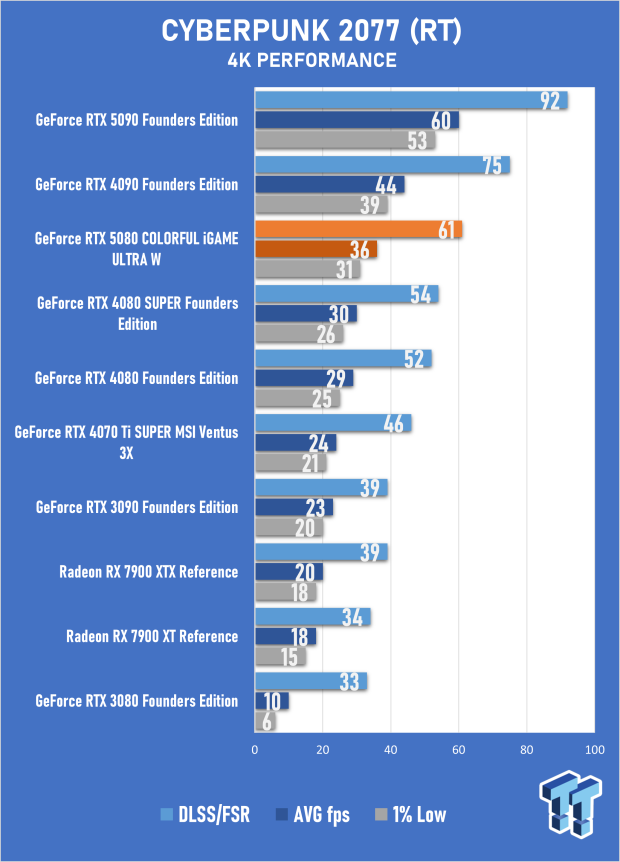
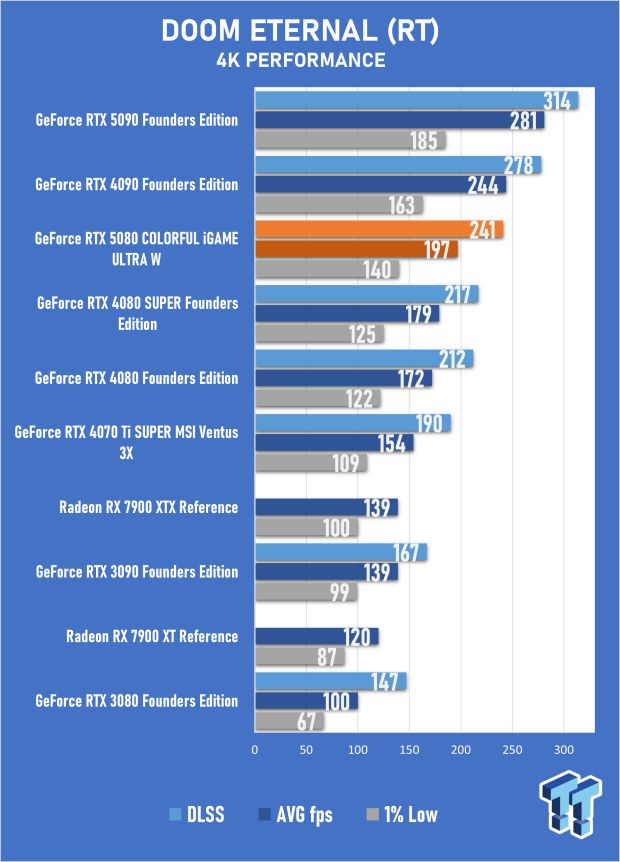
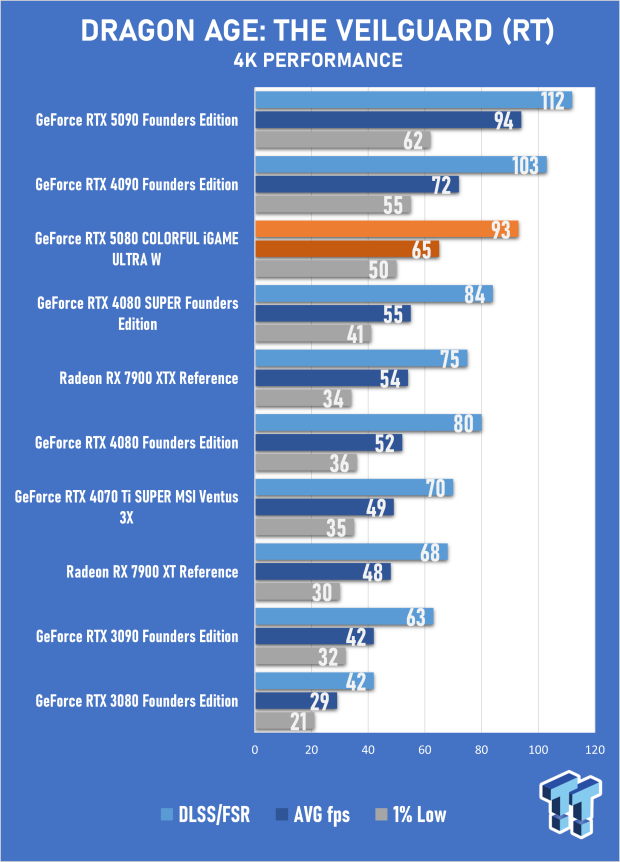
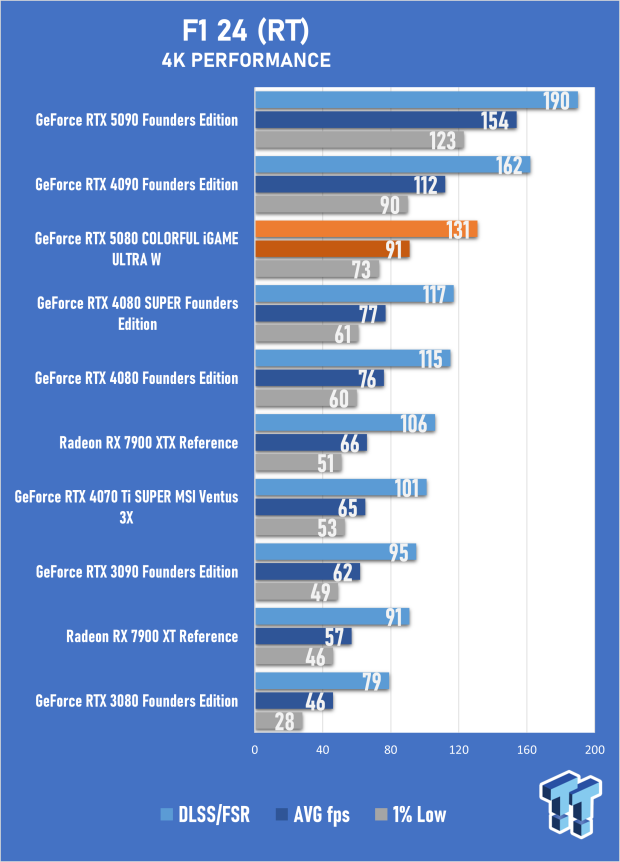
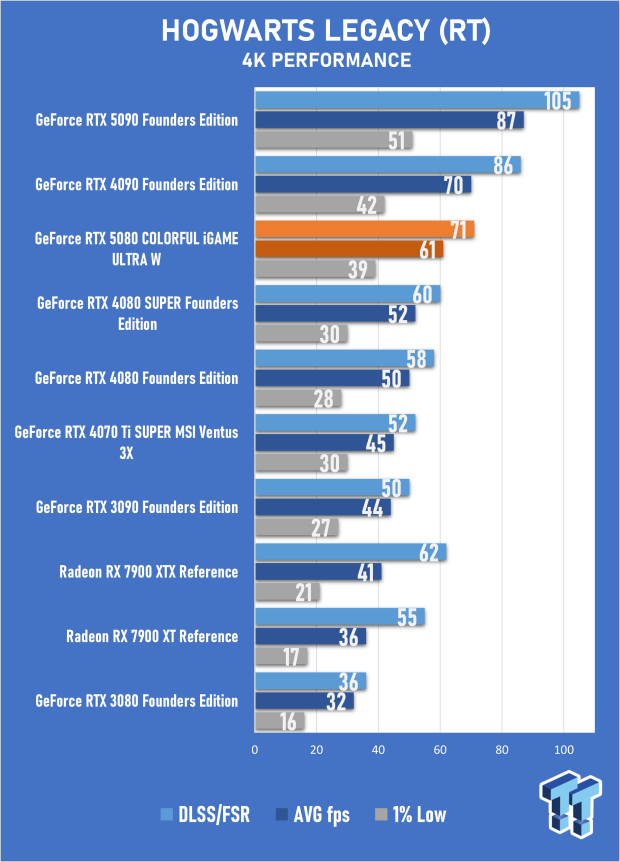
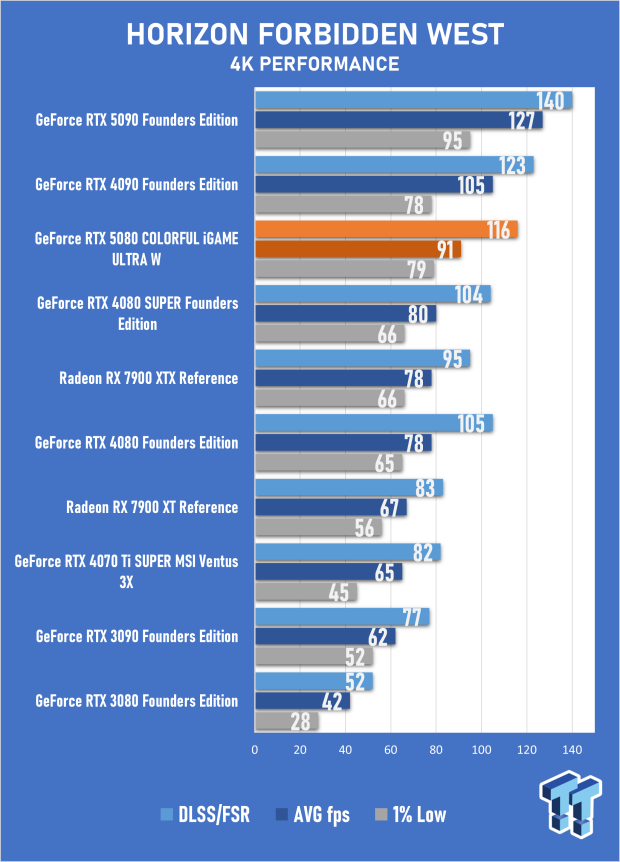
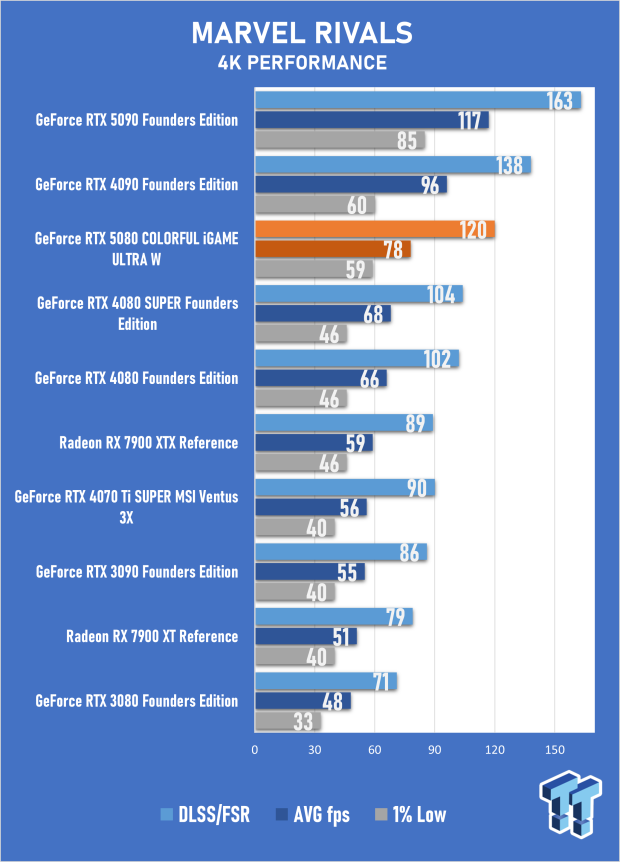
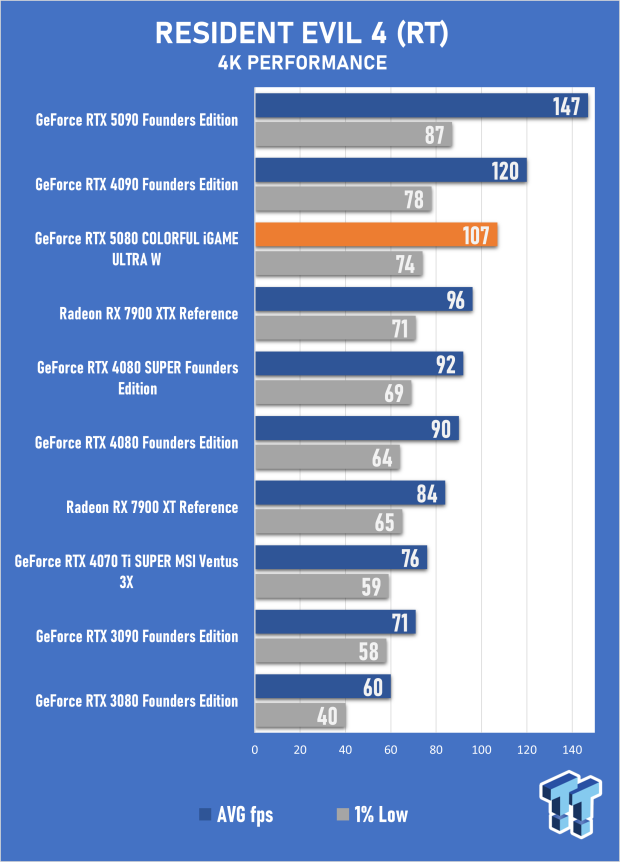
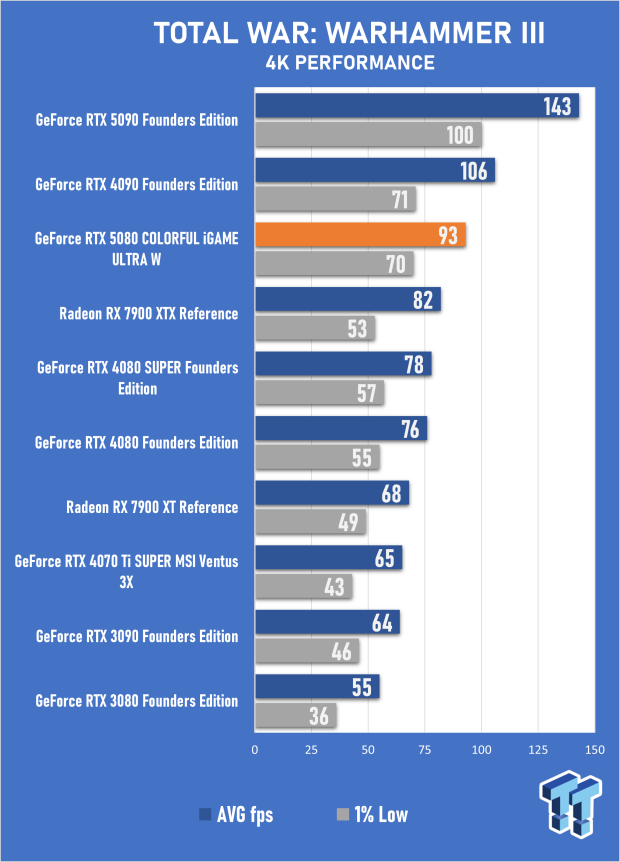
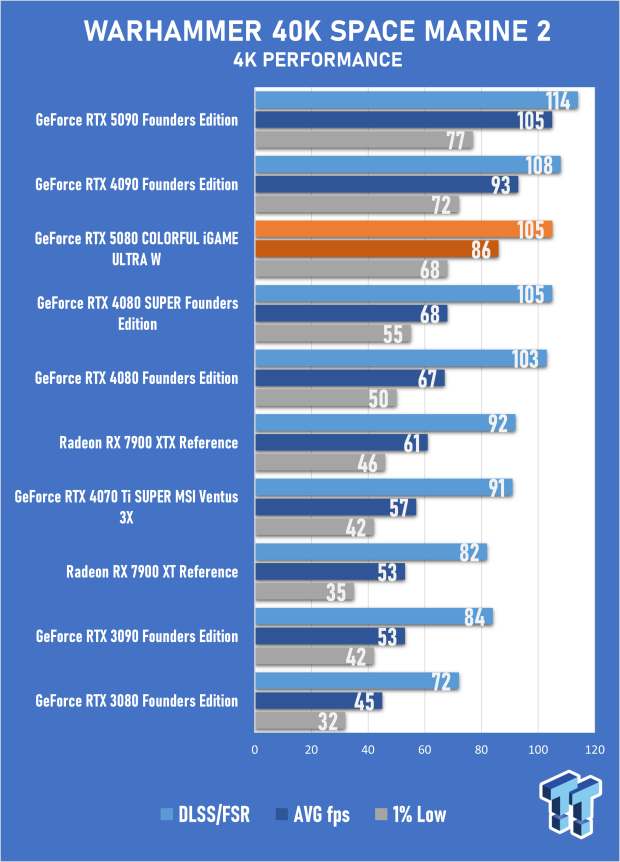
Benchmarks - 1440p Gaming
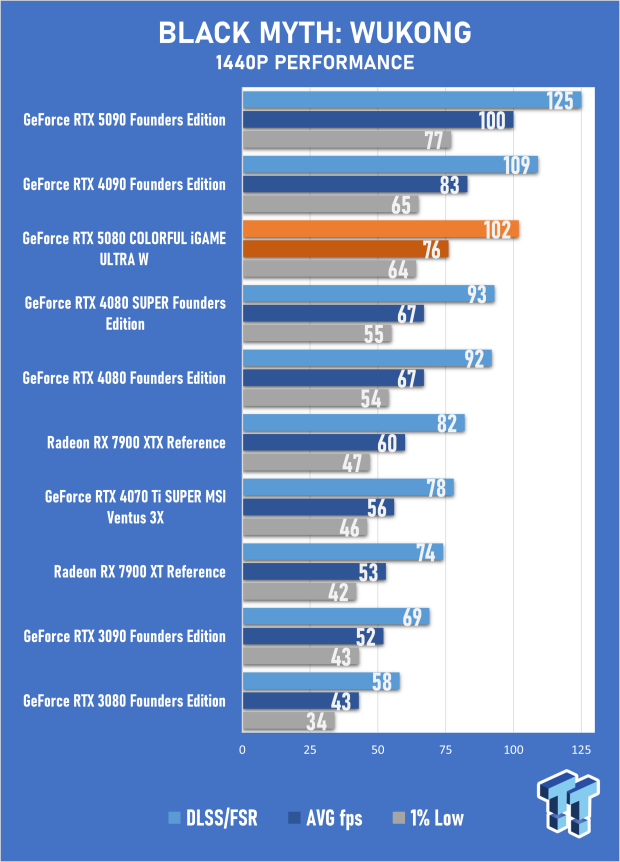
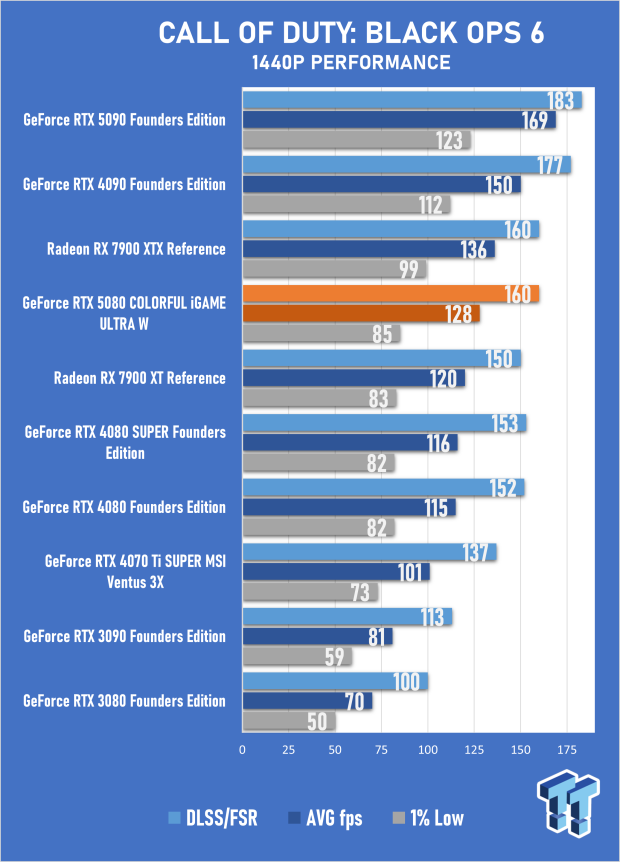
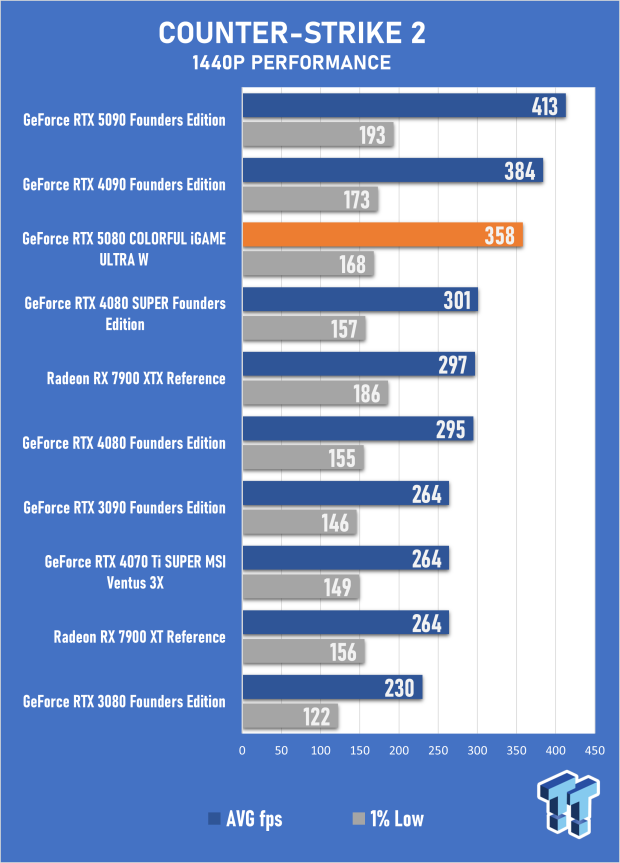
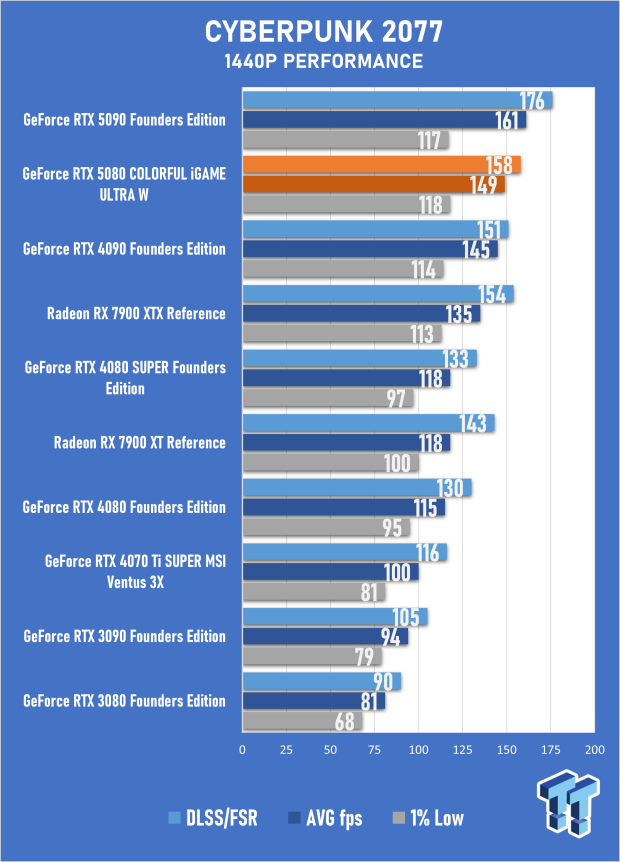
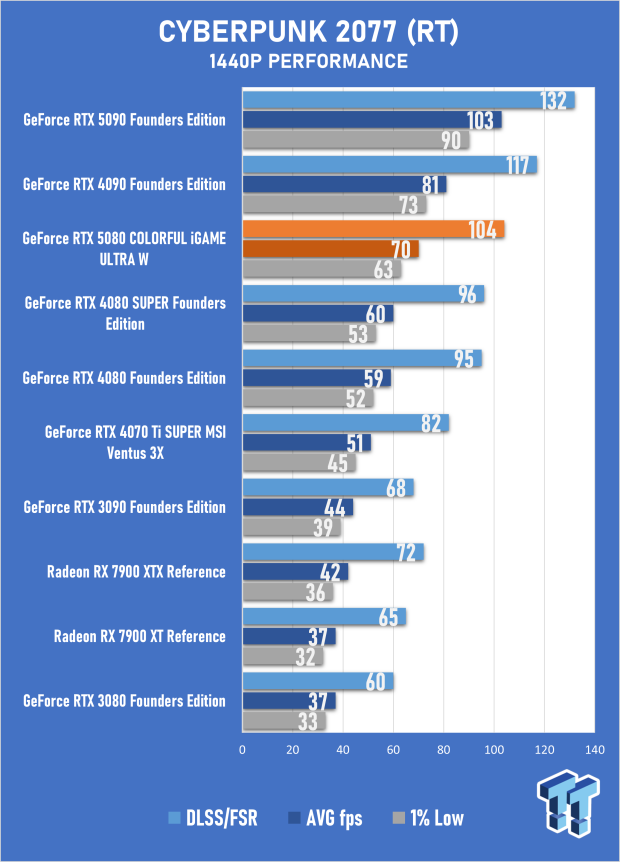
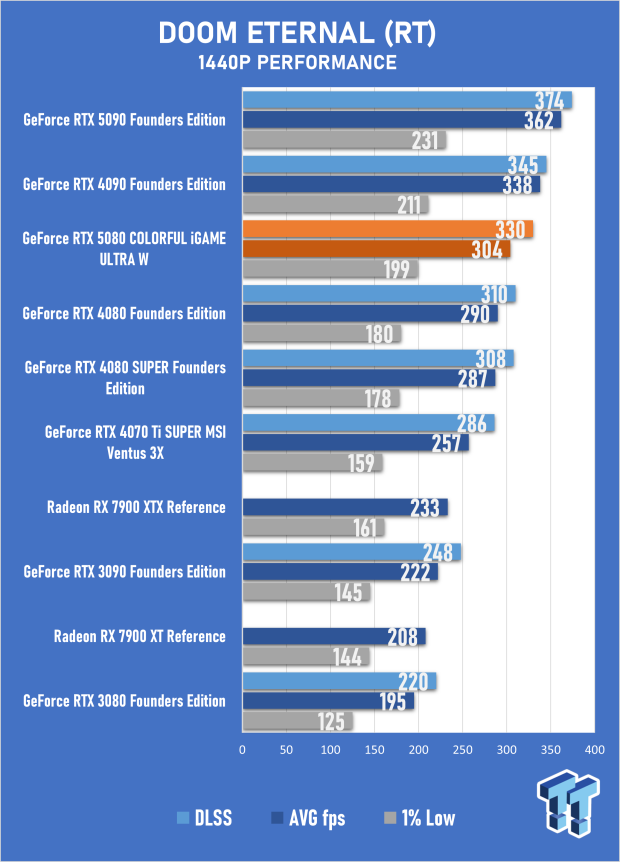
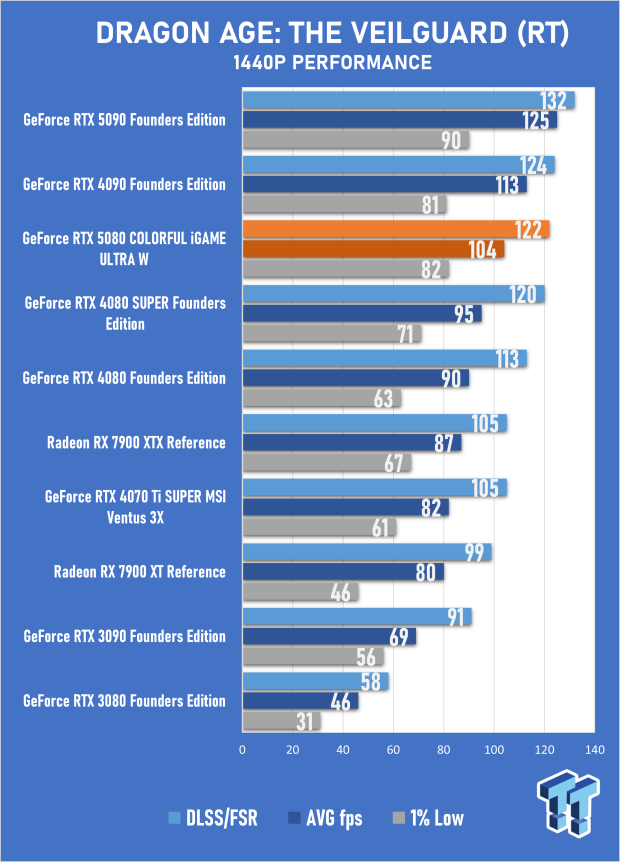
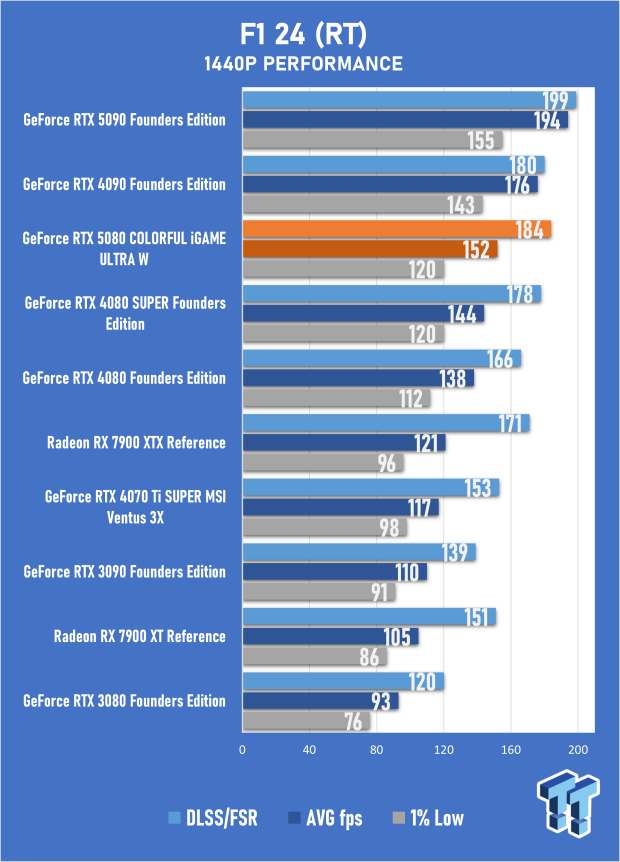
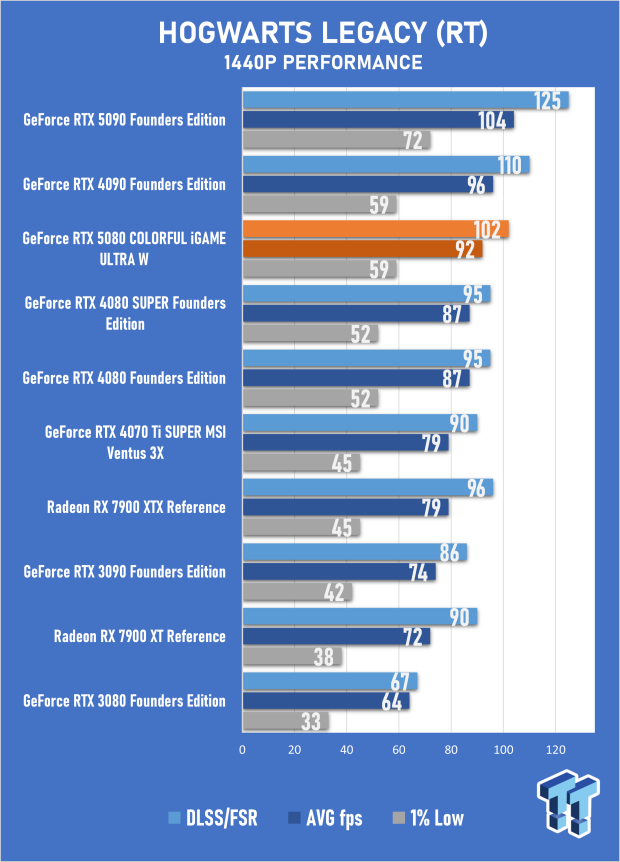
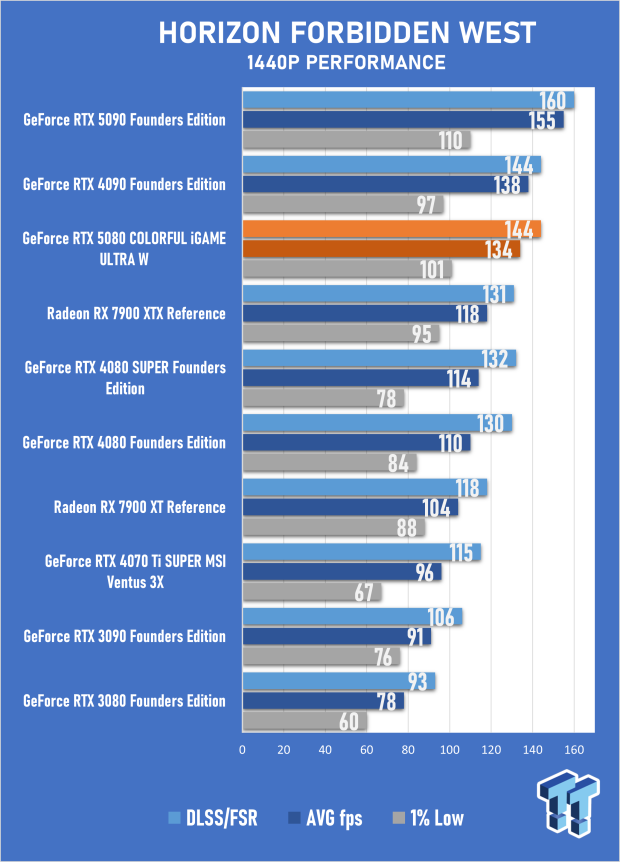
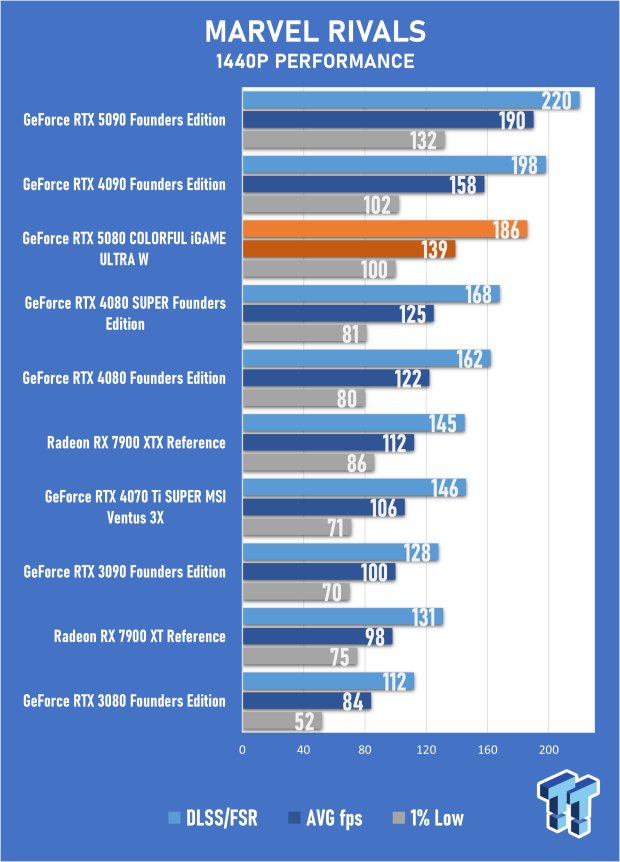
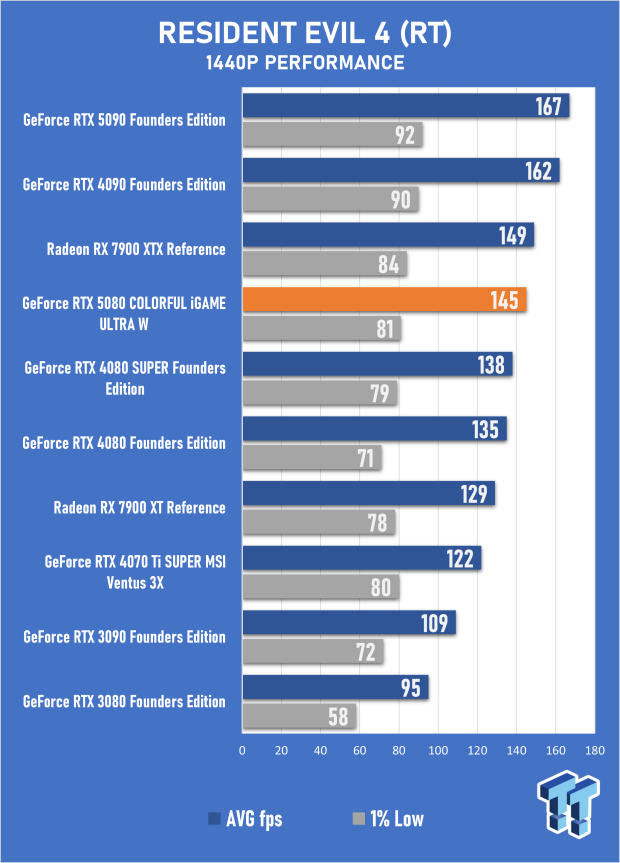
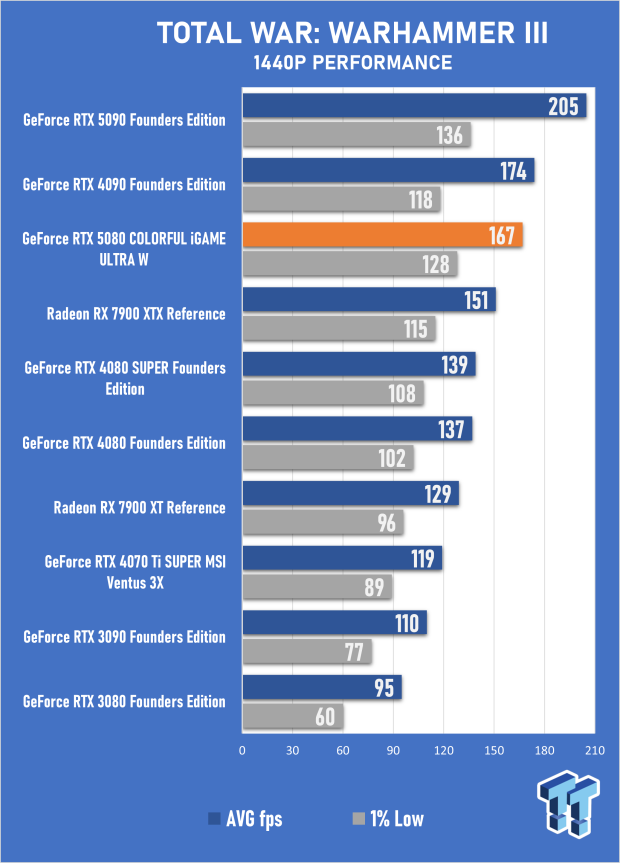
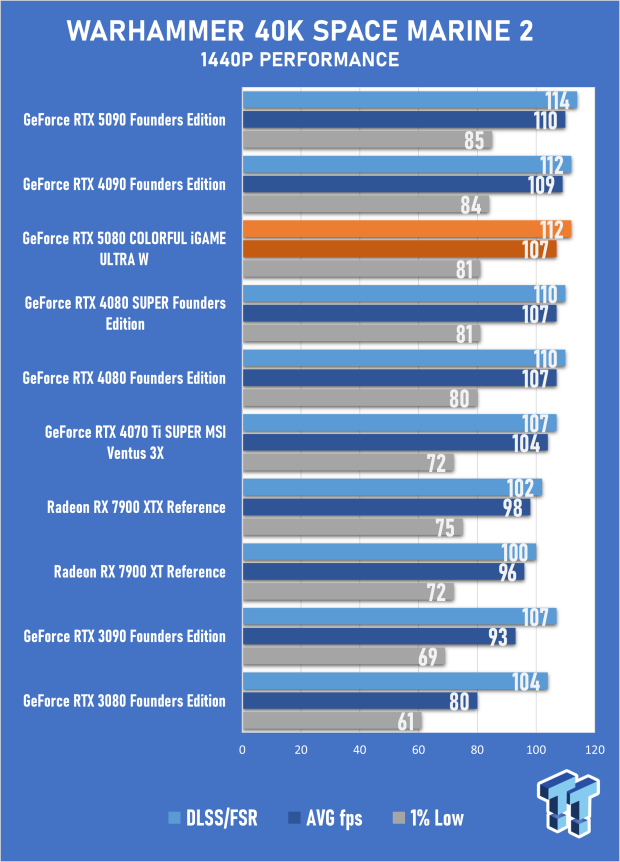
DLSS 4, Frame Generation, and the new Multi-Frame Generation
DLSS 4 and Multi Frame Generation are impressive bits of technology, thanks mainly to the overall improvements to performance and latency on the Frame Generation side and the new 'Transformer' model for Super Resolution and Ray Reconstruction. We used the DLSS 'Quality' mode preset for these benchmarks, often delivering better-than-native image quality.
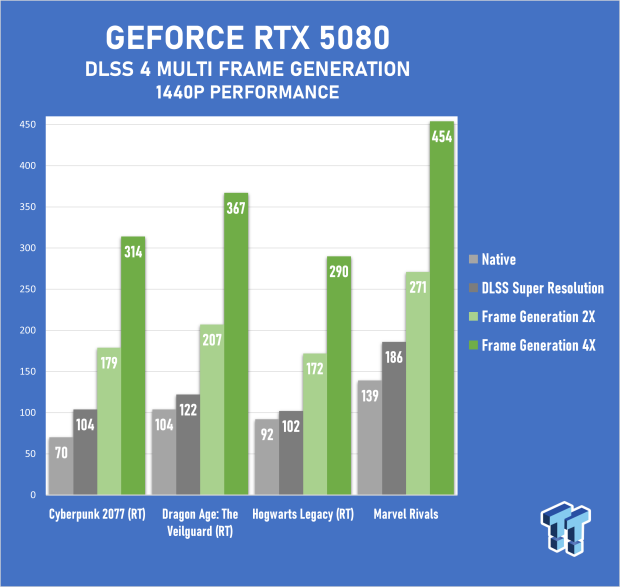
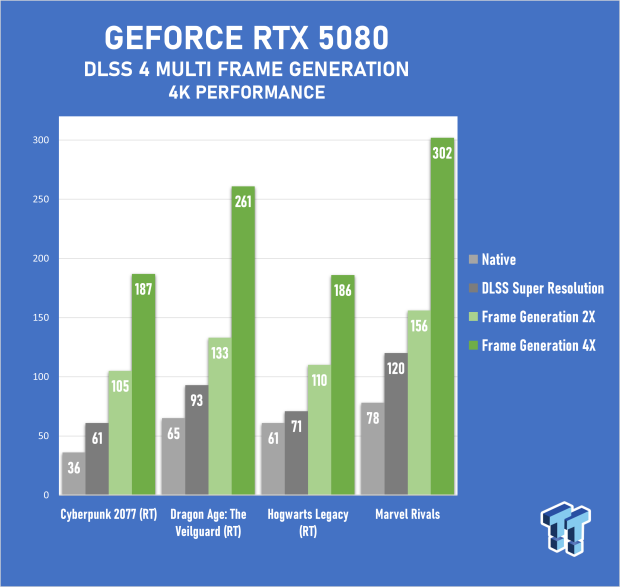
Multi Frame Generation is an excellent and promising new technology designed to make the most out of high refresh-rate displays. As our GPU test bench includes testing on a 4K 240 Hz display, it's rare to see the game get close to taking full advantage of its capabilities. Multi Frame Generation, alongside NVIDIA Reflex for latency reduction, DLSS Super Resolution for upscaling, and RTX Blackwell 'Flip Metering' hardware, delivers a silky smooth experience as long as the baseline performance is around 70-80 FPS. As we conducted our tests using the DLSS Quality preset and the new Transformer model, dropping this to Balanced in 4K improves the overall experience in Cyberpunk 2077 and Hogwarts Legacy.
Frame Generation (2X) and Multi Frame Generation (3X, 4X) require tinkering and testing to get all of the settings right - which is unfortunate for newcomers or those inexperienced with adjusting graphics settings in a PC game - but the effort is worth it. Even with some noticeable artifacts, the overall smoothness and improved motion clarity are hard to ignore. A game like Dragon Age: The Veilguard feels more immersive at 4K 240 FPS than it does running 4K 65 FPS - and compared to native, the latency is lower when you take the 90+ DLSS Quality input. Frame Generation and Multi Frame Generation will be a big part of PC gaming's future, especially when it comes to Full Ray Tracing or Path Tracing.
Path Tracing Performance
Path Tracing, or Full Ray Tracing, arrived with the GeForce RTX 40 Series and DLSS 3 and is leveling up with the GeForce RTX 50 Series and DLSS 4. It's only possible thanks to AI technologies like DLSS Super Resolution, Ray Reconstruction, and RTX Neural Shader technology like RTX Mega Geometry. It's designed specifically for these technologies, and we're only including native or rasterized performance to highlight just how intensive it is on a GPU as powerful as the GeForce RTX 5080. In fact, outside of the massive increase in performance, these games also look notably worse without DLSS 4.
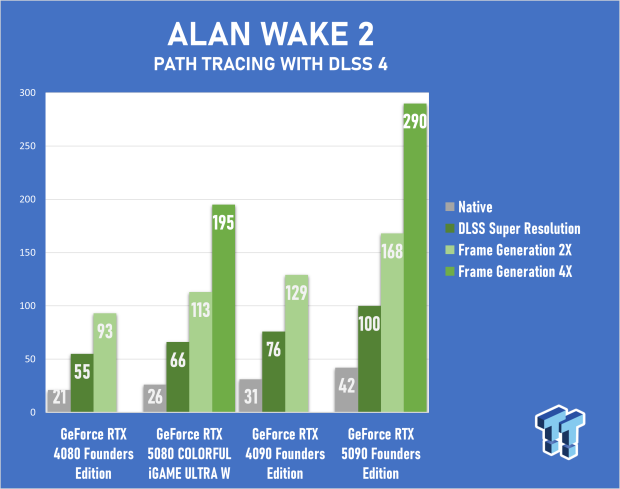
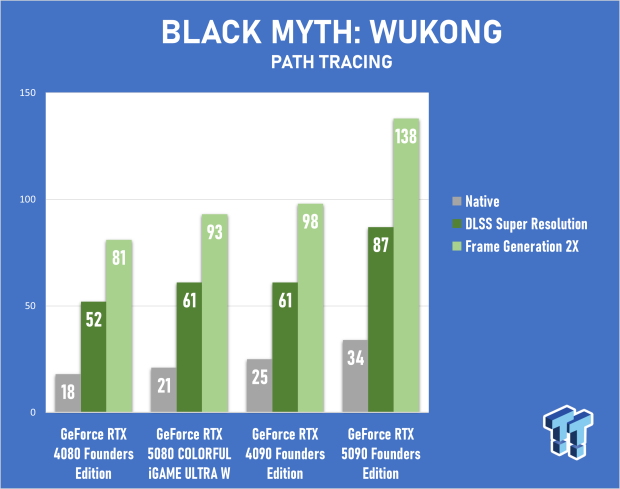
Path Tracing is more than looking at an RTX Off and RTX On comparison clip or screenshot and spotting the difference; it's about being immersed in a jaw-dropping digital world. The magic of realistic lighting doesn't come from a single scene or moment but a collection of moments that add up to deliver a seamless world to explore and get lost in. It's cutting-edge technology and perfect for cinematic titles that push the visual envelope. Alan Wake 2 with DLSS 4, the new Transformer model, and RTX Mega Geometry are sights to behold, as are the lush forests and environments of Black Myth: Wukong.
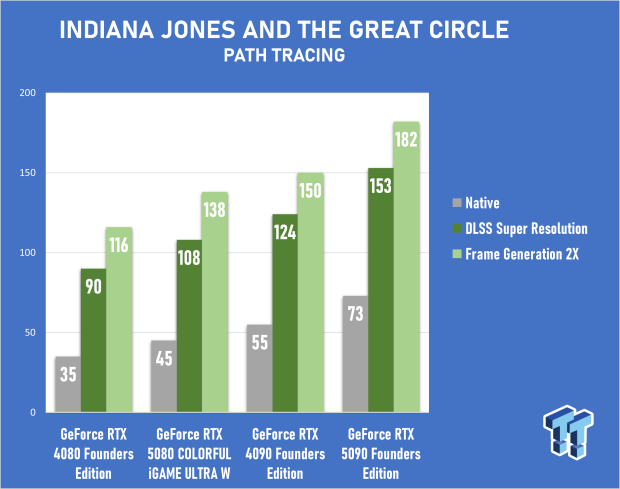
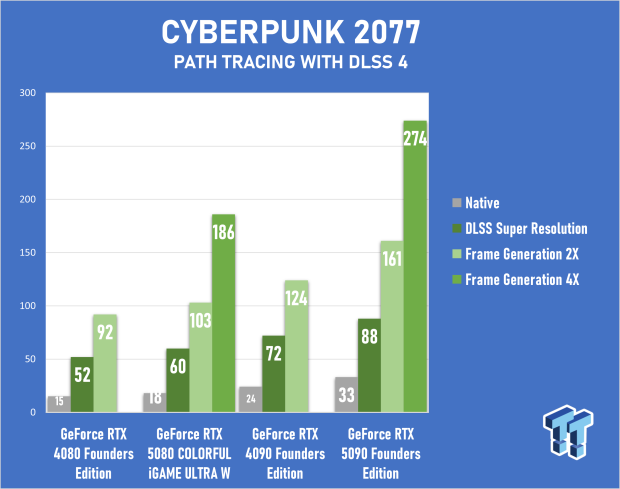
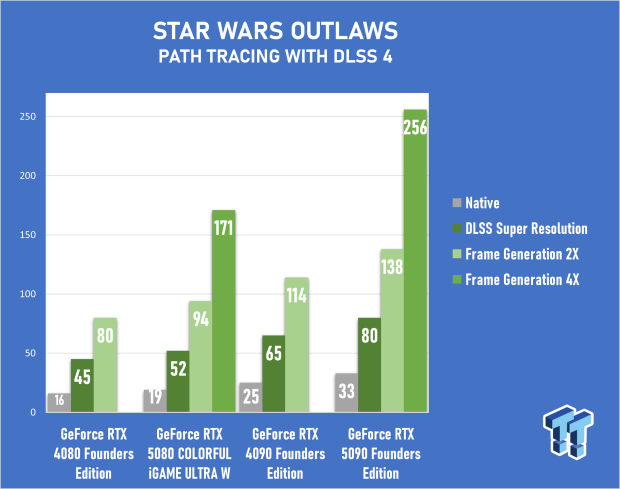
The critically acclaimed Indiana Jones and the Great Circle has yet to get its big DLSS 4 update. It perfectly exemplifies what Full Ray Tracing can bring to a game's visuals and cinematic immersion. This game looks excellent running on an Xbox console or a mainstream GPU like the GeForce RTX 4060. However, jump over to the COLORFUL iGAME GeForce RTX 5080 Ultra W, enable DLSS and Frame Generation, and you've got a genuinely stunning title running at 100+ FPS that looks an entire generation or two ahead of the same game running in 4K on the Xbox Series X.
Temperature and Power Efficiency
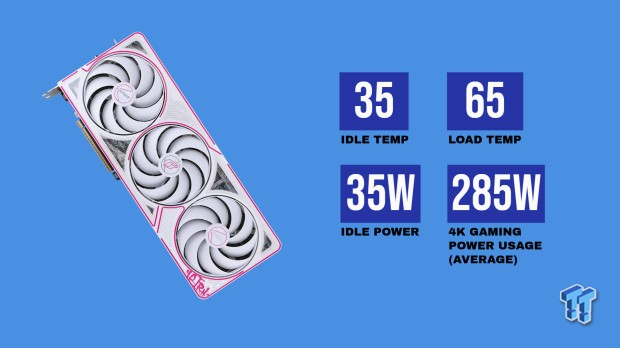
With its 360W power rating, the COLORFUL iGAME GeForce RTX 5080 Ultra W draws more than 300W during heavy gaming workloads, sometimes going all the way up to 350W or so when overclocked. However, the GeForce RTX 5080's power management and scaling are impressive, so the average power usage is well below its capacity when gaming in 4K in a range of titles - especially when you enable DLSS 4. A max temperature of 65 degrees was recorded during our stress test, with audible but minimal noise output; the COLORFUL iGAME GeForce RTX 5080 Ultra W's cooling and thermal performance is impressive. Enough to warrant an additional manual overclock for more performance - even though you probably won't need it.
Final Thoughts
Yes, we would have loved to have seen the GeForce RTX 5080 launch with GeForce RTX 4090 performance levels for $999. Its more modest 22% uplift over the GeForce RTX 4080 for 4K gaming presents better value for those upgrading from lesser hardware or something like the GeForce RTX 3080 or RTX 3090. Upgrading every GPU generation doesn't make sense for most people, even if the gen-on-gen uplift is 30-35%, but thanks to the GeForce RTX 40 Series' massive gen-on-gen gains, the GeForce RTX 5080 in COLORFUL iGAME GeForce RTX 5080 Ultra W form is 88% faster than the GeForce RTX 3080.

Ultimately, these raw performance numbers have become more academic than helpful for daily gamers as technologies like DLSS continue improving and provide tools for enhancing performance and fidelity. When it comes to the GeForce RTX 50 Series, DLSS 4, and the promise of RTX Neural Rendering, it is already giving us a taste of what the AI-enhanced future of gaming will look like. DLSS and real-time ray-tracing have been around for a couple of GPU generations now; however, with the GeForce RTX 50 Series, it feels like we're entering the era where AI is not only becoming essential for boosting performance but also image fidelity, smoothness, and latency, and even rendering more CGI-like detail on the screen.
Regarding custom GeForce RTX 5080 models, the COLORFUL iGAME GeForce RTX 5080 Ultra W is an excellent option if you're cool with the stylish and cool physical design. The thermal performance is great, with enough room to overclock and boost performance, and we're told the price will stick to the $999 MSRP set by NVIDIA.

